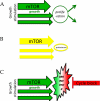Cell cycle arrest is not senescence
- PMID: 21297220
- PMCID: PMC3082019
- DOI: 10.18632/aging.100281
Cell cycle arrest is not senescence
Abstract
DNA damaging agents and radiation, cytotoxins and anti-cancer drugs, telomere erosion and cytokines, culture shock and mitogenic stimuli, oncogenes and tumor suppressors can induce both cell cycle arrest and cellular senescence. Due to this semi-coincidence, senescence is confused with cell cycle arrest, or even more misleadingly, with growth inhibition. With such misconceptions, cellular senescence cannot be linked to organismal aging. Also, the relation between cancer and senescence is distorted. Here I discuss why the link between arrest and senescence is semi-coincidental and how senescence is related to aging and cancer.
Figures




Similar articles
-
Be quiet and you'll keep young: does mTOR underlie p53 action in protecting against senescence by favoring quiescence?Aging (Albany NY). 2011 Jan;3(1):3-4. doi: 10.18632/aging.100257. Aging (Albany NY). 2011. PMID: 21248373 Free PMC article. No abstract available.
-
p63: a new link between senescence and aging.Cell Cycle. 2006 Feb;5(3):260-5. doi: 10.4161/cc.5.3.2415. Epub 2006 Feb 1. Cell Cycle. 2006. PMID: 16434880 Review.
-
The p53 inducing drug dosage may determine quiescence or senescence.Aging (Albany NY). 2010 Nov;2(11):748. doi: 10.18632/aging.100229. Aging (Albany NY). 2010. PMID: 21068468 Free PMC article. No abstract available.
-
Cell cycle arrest is not yet senescence, which is not just cell cycle arrest: terminology for TOR-driven aging.Aging (Albany NY). 2012 Mar;4(3):159-65. doi: 10.18632/aging.100443. Aging (Albany NY). 2012. PMID: 22394614 Free PMC article.
-
Cell senescence and hypermitogenic arrest.EMBO Rep. 2003 Apr;4(4):358-62. doi: 10.1038/sj.embor.embor806. EMBO Rep. 2003. PMID: 12671679 Free PMC article. Review.
Cited by
-
Advances in targeting signal transduction pathways.Oncotarget. 2012 Dec;3(12):1505-21. doi: 10.18632/oncotarget.802. Oncotarget. 2012. PMID: 23455493 Free PMC article. Review.
-
Common drugs and treatments for cancer and age-related diseases: revitalizing answers to NCI's provocative questions.Oncotarget. 2012 Dec;3(12):1711-24. doi: 10.18632/oncotarget.890. Oncotarget. 2012. PMID: 23565531 Free PMC article.
-
IL1- and TGFβ-Nox4 signaling, oxidative stress and DNA damage response are shared features of replicative, oncogene-induced, and drug-induced paracrine 'bystander senescence'.Aging (Albany NY). 2012 Dec;4(12):932-51. doi: 10.18632/aging.100520. Aging (Albany NY). 2012. PMID: 23385065 Free PMC article.
-
Simultaneous Targeting Tumor Cells and Cancer-Associated Fibroblasts with a Paclitaxel-Hyaluronan Bioconjugate: In Vitro Evaluation in Non-Melanoma Skin Cancer.Biomedicines. 2021 May 24;9(6):597. doi: 10.3390/biomedicines9060597. Biomedicines. 2021. PMID: 34073987 Free PMC article.
-
Tunable and dynamic soft materials for three-dimensional cell culture.Soft Matter. 2013 Aug 7;9(29):6737-6746. doi: 10.1039/C3SM50217A. Soft Matter. 2013. PMID: 23930136 Free PMC article.
References
-
- Wullschleger S, Loewith R, Hall MN. TOR signaling in growth and metabolism. Cell. 2006;124:471–484. - PubMed
-
- Blagosklonny MV. Cell senescence: hypertrophic arrest beyond restriction point. J Cell Physiol. 2006;209:592–597. - PubMed
-
- Sherr CJ, DePinho RA. Cellular senescence: mitotic clock or culture shock? Cell. 2000;102:407–410. - PubMed
Publication types
MeSH terms
Substances
LinkOut - more resources
Full Text Sources
Other Literature Sources

